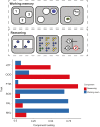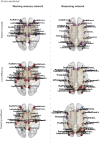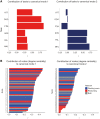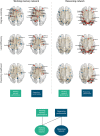Distinct patterns of structural damage underlie working memory and reasoning deficits after traumatic brain injury
- PMID: 32243506
- PMCID: PMC7174032
- DOI: 10.1093/brain/awaa067
Distinct patterns of structural damage underlie working memory and reasoning deficits after traumatic brain injury
Abstract
It is well established that chronic cognitive problems after traumatic brain injury relate to diffuse axonal injury and the consequent widespread disruption of brain connectivity. However, the pattern of diffuse axonal injury varies between patients and they have a correspondingly heterogeneous profile of cognitive deficits. This heterogeneity is poorly understood, presenting a non-trivial challenge for prognostication and treatment. Prominent amongst cognitive problems are deficits in working memory and reasoning. Previous functional MRI in controls has associated these aspects of cognition with distinct, but partially overlapping, networks of brain regions. Based on this, a logical prediction is that differences in the integrity of the white matter tracts that connect these networks should predict variability in the type and severity of cognitive deficits after traumatic brain injury. We use diffusion-weighted imaging, cognitive testing and network analyses to test this prediction. We define functionally distinct subnetworks of the structural connectome by intersecting previously published functional MRI maps of the brain regions that are activated during our working memory and reasoning tasks, with a library of the white matter tracts that connect them. We examine how graph theoretic measures within these subnetworks relate to the performance of the same tasks in a cohort of 92 moderate-severe traumatic brain injury patients. Finally, we use machine learning to determine whether cognitive performance in patients can be predicted using graph theoretic measures from each subnetwork. Principal component analysis of behavioural scores confirm that reasoning and working memory form distinct components of cognitive ability, both of which are vulnerable to traumatic brain injury. Critically, impairments in these abilities after traumatic brain injury correlate in a dissociable manner with the information-processing architecture of the subnetworks that they are associated with. This dissociation is confirmed when examining degree centrality measures of the subnetworks using a canonical correlation analysis. Notably, the dissociation is prevalent across a number of node-centric measures and is asymmetrical: disruption to the working memory subnetwork relates to both working memory and reasoning performance whereas disruption to the reasoning subnetwork relates to reasoning performance selectively. Machine learning analysis further supports this finding by demonstrating that network measures predict cognitive performance in patients in the same asymmetrical manner. These results accord with hierarchical models of working memory, where reasoning is dependent on the ability to first hold task-relevant information in working memory. We propose that this finer grained information may be useful for future applications that attempt to predict long-term outcomes or develop tailored therapies.
Keywords: graph theory; reasoning; structural connectome; traumatic brain injury; working memory.
© The Author(s) (2020). Published by Oxford University Press on behalf of the Guarantors of Brain.
Figures








References
-
- Bassett DS, Bullmore E.. Small-world brain networks. Neuroscientist 2006; 12: 512–23. - PubMed
-
- Braun U, Muldoon SF, Bassett DS.. On human brain networks in health and disease In: eLS. Chichester: John Wiley & Sons, Ltd; 2015.
Publication types
MeSH terms
Grants and funding
LinkOut - more resources
Full Text Sources
Medical

